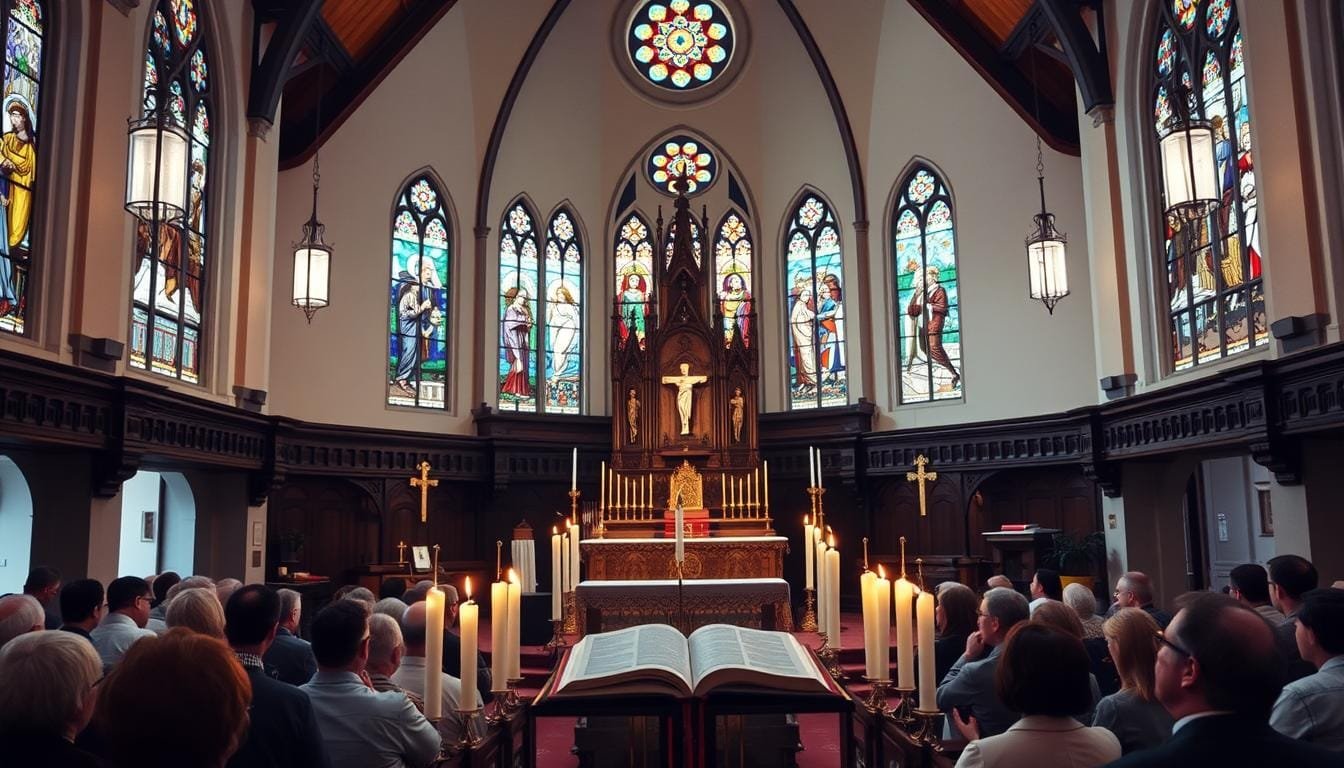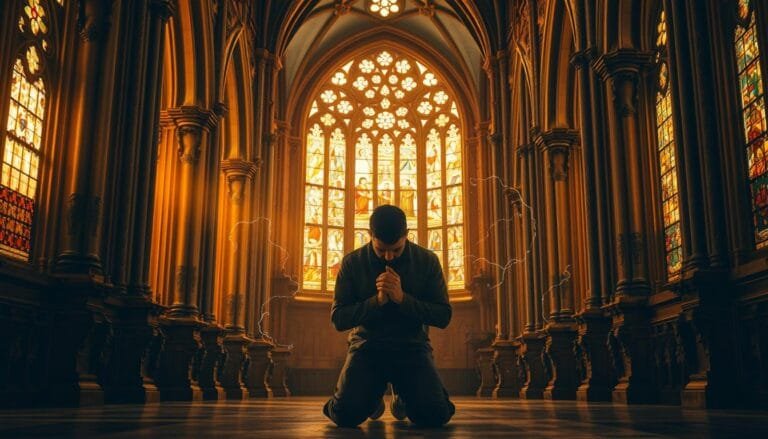How Much Of The Bible Is Read In a Catholic Mass?
This website contains affiliate links. As an Amazon Associate, I earn from qualifying purchases. The content on this website was created with the help of AI.
75% of key verses in Catholic Mass come from the New Testament. This shows how important Scripture is in Catholic worship.
Let’s explore how much of the Bible is read in a Catholic Mass.
The Catholic Mass includes large parts of the Bible throughout the year. The Liturgy of the Word shares readings from both Testaments.
These follow a three-year cycle, covering many biblical passages and themes.
Scripture is crucial in shaping the Mass experience. The readings cover various stories and teachings. This helps deepen faith and encourages spiritual growth among believers.
The Mass has two main parts: Liturgy of the Word and Liturgy of Eucharist. Scripture readings are key to the Liturgy of the Word.
This ensures Catholics regularly encounter God’s Word during worship.
Key Takeaways
- 75% of key verses in Catholic Mass are from the New Testament
- Scripture readings follow a three-year cycle
- The Mass includes readings from both the Old and New Testaments
- Liturgy of the Word focuses on sharing biblical passages
- Regular exposure to Scripture aids in faith formation
Understanding the Structure of Catholic Mass Readings
The Liturgy of the Word is a crucial part of Catholic Mass. It brings Scripture to life for the faithful. Let’s explore how the Church organizes these readings for worship.
The Liturgy of the Word Components
A typical Sunday Mass includes four main Scripture readings:
- A passage from the Hebrew Scriptures (Old Testament)
- A Responsorial Psalm
- A reading from the New Testament letters
- A Gospel reading
The Gospel reading is the high point of the Liturgy. It’s often followed by the Nicene Creed. This setup connects ancient prophecies to their fulfillment in Christ.
Three-Year Lectionary Cycle Overview
The Catholic Church uses a three-year lectionary cycle for Sunday readings. Each year focuses on a specific Gospel:
- Year A: Matthew
- Year B: Mark
- Year C: Luke
John’s Gospel is featured during Easter across all three years. This cycle ensures we hear a wide range of Scripture over time.
Special Feast Day and Holiday Readings
The Church has special readings for feast days and liturgical seasons. These passages focus on unique themes for each celebration. They enrich our faith journey throughout the year.
The Lectionary contains organized Scripture readings for Mass. It links Old Testament passages with Gospel themes. This creates a coherent message for reflection.
Mass readings provide a solid foundation for faith. However, personal Bible study is key for deeper understanding. It helps us grasp salvation history more fully.
Daily Scripture Readings in Catholic Mass
Catholic Mass includes daily readings from the Bible. These passages offer a rich exploration of salvation history throughout the year.
The selection process ensures a comprehensive journey through Scripture.
The structure of daily readings follows a specific pattern:
- Weekdays feature at least two readings
- Sundays and solemnities include three readings
The Catholic Church organizes these readings into cycles:
| Cycle Type | Duration | Focus |
|---|---|---|
| Sunday | Three years (A, B, C) | Year A: Matthew, Year B: Mark and John 6, Year C: Luke |
| Weekday | Two years (I, II) | Same Gospels for both years |
This system ensures Catholics encounter various biblical texts over time. The New American Bible translation is used in U.S. dioceses.
Since Vatican II, Scripture readings have expanded during Mass. Sundays and major feast days now include Old Testament passages. This change enriches our understanding of salvation history.
“Let the word of Christ dwell in you richly.” – Colossians 3:16
Through these readings, we connect with God’s word daily. This practice deepens our Catholic faith and understanding of its teachings.
How Much Of The Bible Is Read In A Catholic Mass?
Catholic Mass offers a rich tapestry of scripture throughout the liturgical year. We experience a significant portion of the Bible during Mass.
Carefully selected readings provide a comprehensive understanding of our faith.
First Reading Coverage from the Old Testament
Old Testament readings form the foundation of our liturgical experience. Less than 4% is read during Mass due to its length. These selections provide crucial context for the Gospel.
On Sundays, the first reading typically comes from the Old Testament. It offers insights that resonate with the day’s Gospel message.
Second Reading from New Testament Letters
The second reading usually draws from New Testament epistles, covering about 25% of these texts.
These readings offer guidance for Christian living. They deepen our understanding of apostolic teachings.
The lectionary’s structure ensures we encounter a variety of epistles throughout the year.
Gospel Reading Selection Process
The Gospel selection is the centerpiece of the Liturgy of the Word. About 60% of the New Testament gospels are read over a three-year cycle.
This approach ensures we encounter Jesus’ life and teachings comprehensively.
The entire lectionary covers about 90% of the Gospels. It includes 55% of the rest of the New Testament. Slightly over 13% of the Old Testament is covered.
This careful selection process ensures we receive a balanced diet of scripture. It nurtures our faith and understanding through various biblical texts.
The Role of the Lectionary in Mass Readings
The Catholic lectionary organizes Bible passages for Mass readings. It selects Scripture throughout the liturgical year. This guides the faithful through important biblical texts.
Organization of Biblical Passages
The lectionary covers key parts of the Bible over time. During Ordinary Time, the Gospels of Matthew, Mark, and Luke are read.
This allows followers to experience Jesus’ ministry. They learn about His teachings and miracles.
Seasonal Reading Arrangements
Readings match the liturgical seasons. Advent and Lent focus on preparation and repentance. Old Testament readings connect with the Gospel.

Weekday vs. Sunday Reading Selections
Bible passages are organized differently for weekdays and Sundays. Weekday readings follow a two-year cycle. Sunday readings use a three-year cycle.
This setup helps explore God’s Word throughout the year.
| Reading Type | Cycle Length | Coverage |
|---|---|---|
| Sunday Readings | 3 years | Additional 31% of the New Testament, 10% of Old Testament |
| Weekday Readings | 2 years | 72% of the New Testament, 14% of Old Testament |
| Total Coverage | 3 years (including weekdays) | 72% of the New Testament, 14% of the Old Testament |
This method helps Catholics engage with various biblical texts. It deepens their understanding of God’s Word. The approach covers different parts of Scripture throughout the year.
Biblical Integration Throughout Mass Parts
The Catholic Mass is a tapestry woven with Scripture. Bible references appear throughout the entire celebration, not just in the Liturgy of the Word.
Liturgical prayers are rich with biblical language, creating a deep faith experience.
Opening and closing prayers often draw from Scripture. These moments connect us to the timeless words of the Bible.
The Prayers of the Faithful echo biblical themes, addressing Church and world needs.
The Eucharistic Prayers bring the Last Supper to life. These prayers remind us of Christ’s sacrifice, rooted in Gospel accounts.
The Word becomes flesh before our eyes, uniting Scripture and Eucharist.
“Singing is for one who loves,” St. Augustine reminds us. Music in Mass often comes straight from the Psalms, expressing our deepest joys and sorrows.
Our physical actions during Mass reflect biblical traditions. Standing, sitting, and kneeling connect us to ancient worship practices.
These gestures create a bodily prayer, uniting us as one community before God.
Scripture integration in Catholic worship creates profound unity. The Mass immerses us in God’s Word from start to finish. It brings the Bible to life in a unique and powerful way.
The Significance of Scripture Selection in Catholic Worship
Scripture selection is vital in Catholic worship. It greatly impacts our faith journey. Carefully chosen readings enhance our understanding of God’s message.
Theological Importance of Reading Rotation
Catholic Scripture selection follows a planned rotation. This system exposes us to various biblical texts over time. It deepens our grasp of God’s revelation.
The Sunday Lectionary operates on a three-year cycle. The weekday Lectionary follows a two-year pattern.

Connection to Liturgical Seasons
Readings are linked to liturgical seasons, highlighting each period’s themes. Advent focuses on preparation and anticipation. Lent brings reflections on repentance and renewal.
This alignment of Scripture with the Church calendar enriches our worship experience.
Impact on Catholic Faith Formation
Scripture in Mass plays a crucial role in faith formation. It nurtures spiritual growth and fosters a closer relationship with God.
The Sunday and weekday cycles cover 70% of the New Testament. They also include 14% of the Old Testament.
This exposure to key biblical passages shapes our understanding of salvation. It guides our daily lives as Catholics.
“The word of God is living and active, sharper than any two-edged sword, piercing until it divides soul from spirit, joints from marrow; it is able to judge the thoughts and intentions of the heart.” – Hebrews 4:12
Scripture selection forms the backbone of our Catholic faith journey. It provides a rich tapestry of God’s word. This guides us through life’s seasons and deepens our spiritual understanding.
Enhancing Scripture Understanding Through Mass
The Catholic Mass offers a unique way to deepen our understanding of Scripture. We hear the Bible read aloud and reflected upon in the homily.
This communal approach to Catholic Bible study engages us with God’s Word.
Mass readings cover a significant portion of the Bible over time. Nearly the entire Bible is read aloud in Catholic Mass readings every three years.
This ensures we’re exposed to a wide range of biblical passages.
The structure of Mass readings is thoughtfully designed. Each Sunday, we hear four readings:
- Old Testament reading
- Psalm
- New Testament reading (often from Paul’s letters)
- Gospel reading
These readings connect the Old Testament with the Gospel. The Psalm serves as a bridge between them. This arrangement helps us see the unity of Scripture.
The homily provides context, explanation, and application of the day’s readings. It helps us grasp the deeper meanings of biblical texts.
This guided reflection makes Scripture more relevant to our lives.
| Aspect of Mass | Scripture Engagement |
|---|---|
| Readings | Hearing Bible passages read aloud |
| Homily | Guided interpretation and application |
| Responses | Active participation with biblical phrases |
| Prayers | Many rooted in Scripture |
Active participation in Mass allows us to hear and respond to God’s Word. This engagement fosters a deeper connection with Scripture. It also encourages ongoing Catholic Bible study beyond the church walls.
Conclusion
The Scripture in worship plays a vital role in Catholic Mass. Over three years, we encounter a large portion of God’s Word. This fosters spiritual growth and deepens our faith.
The Mass Bible coverage provides a comprehensive journey through Scripture. Each reading is chosen to light our path. This approach helps us apply biblical wisdom to our daily lives.
42.5% of the Bible is read during Sundays and Holy Days. Daily Mass attendees experience even more Scripture. This coverage, along with homilies, nourishes our spirits.
Engaging with Scripture in worship opens us to God’s love and wisdom. It creates powerful opportunities for transformation.
Through this, we become active participants in our faith journey.













